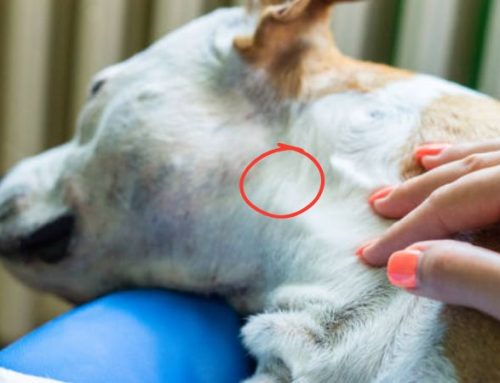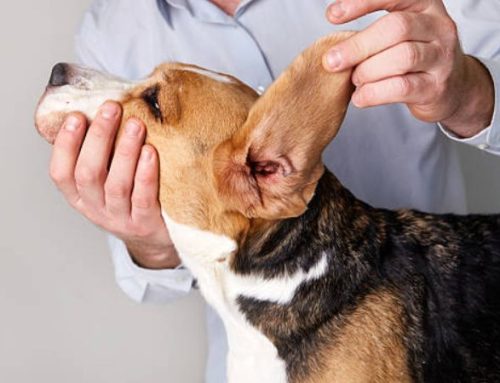Most cats approach mealtime with eager paws and curious noses, but for a small number, certain foods can trigger more than just satisfaction they can spark uncomfortable reactions that affect their skin, digestion, and overall well-being. If you’ve noticed your feline friend scratching, vomiting, or showing other unusual symptoms after eating, it might be time to explore the world of cat food allergies.
Today, we’ll guide you through what foods cats can be allergic to, how to recognize the signs, and the best ways to help your furry companion feel healthy and happy again.

Common Causes of Cat Food Allergies
Food allergies in cats occur when a feline’s immune system mistakenly identifies a specific dietary component as harmful, triggering an overactive immune response. While true food allergies are relatively rare affecting only about 1% of all cats they can have a significant impact on a cat’s skin, digestive system, and overall well-being. Understanding what ingredients are most likely to cause reactions, as well as the underlying factors that contribute to these sensitivities, is essential for preventing flare-ups and maintaining your cat’s health.
Typical Allergenic Ingredients
The majority of food allergies in cats are caused by proteins. Proteins are complex molecules that the immune system can mistakenly recognize as threats, even if the cat has previously consumed them without any issues. The most common protein sources that trigger allergic reactions in cats include:
- Beef: Frequently implicated in cat food allergies due to its widespread use in commercial cat foods. Even small amounts can provoke immune reactions in sensitive cats.
- Chicken: Another highly common allergen, chicken can cause skin issues such as itching, hair loss, and lesions, as well as gastrointestinal upset in some cats.
- Fish: While often considered a healthy protein source, fish can also be a common trigger, especially in cats with previous exposure.
In addition to these primary allergens, some cats may react to dairy products, which contain proteins like casein and whey that are difficult for certain cats to digest or tolerate. Symptoms may include gastrointestinal upset, skin irritation, or chronic itching.
Less Common Triggers
Although less frequently encountered, several other food ingredients have been documented as causes of feline allergies:
- Lamb: Once considered a hypoallergenic option, lamb can still cause reactions in some cats, particularly if they have been exposed over time.
- Egg: Eggs are a source of high-quality protein but can occasionally trigger immune responses.
- Barley and other grains: While grain allergies are less common than protein allergies, some cats show sensitivities to ingredients like barley, wheat, or corn.
- Rabbit: Novel protein sources such as rabbit are generally used in hypoallergenic diets, but they can still provoke reactions in rare cases.
It is important to remember that any food ingredient has the potential to cause an allergic reaction. Even foods considered “safe” can become problematic if a cat is exposed over a long period or develops a heightened immune sensitivity.
The Role of Genetics
Genetics play a significant role in a cat’s susceptibility to food allergies. While any breed can develop a food allergy, research indicates that certain breeds particularly Siamese cats and Siamese mixes—appear to have a higher predisposition. A genetic tendency may affect how a cat’s immune system responds to specific proteins, making some individuals more likely to react than others, even with similar diets.
Long-Term Exposure and Sensitization
A unique feature of food allergies in cats is that they often develop after repeated exposure to the allergenic ingredient. A cat may eat a particular protein for months or years without issue, and suddenly, the immune system mounts an abnormal response. This phenomenon, called sensitization, occurs because the immune system has “learned” to recognize the protein as harmful after repeated contact. Consequently, long-term exposure even to a previously tolerated ingredient can eventually result in a food allergy.
This delayed onset also underscores the importance of monitoring your cat’s health over time. Sudden skin issues, gastrointestinal upset, or chronic itching even in adult cats may signal a newly developed food allergy, rather than an environmental or flea-related cause.
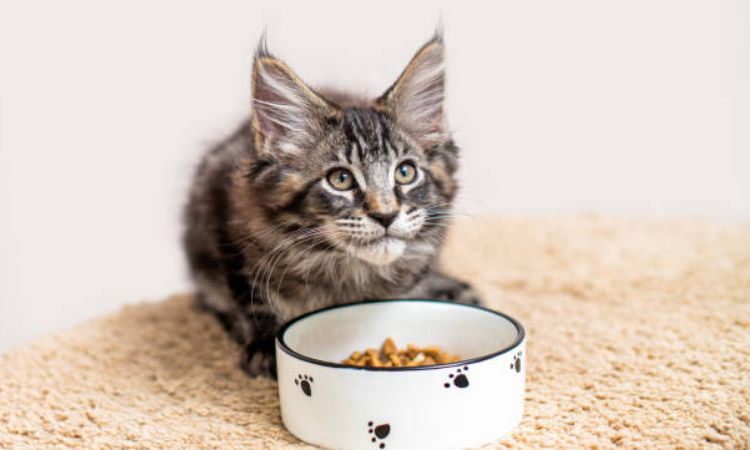
Symptoms of Food Allergies in Cats
Skin Symptoms
Skin-related issues are among the most common signs of food allergies in cats. Persistent itching is a hallmark symptom and can occur year-round, unlike seasonal allergies. Cats may show scratching, licking, or overgrooming behavior that leads to visible skin changes. Common dermatologic symptoms include:
- Itching (pruritus): Often concentrated on the head, neck, and ears but can affect the entire body. Persistent scratching is a red flag for possible food allergy.
- Rashes and redness: The skin may appear inflamed, irritated, or slightly raised in affected areas.
- Hair loss (alopecia): Caused by self-grooming, scratching, or biting at irritated spots. Hair loss can be patchy or widespread depending on the severity of the allergic reaction.
- Lesions and sores: Cats may develop miliary dermatitis (small crusted bumps), ulcerations, plaques, or other self-induced trauma from constant scratching or biting.
- Secondary infections: Continuous scratching and open lesions can lead to bacterial or yeast infections, worsening the cat’s discomfort.
These skin symptoms may resemble other conditions, which is why a veterinary examination is necessary before assuming a food allergy is the cause.
Digestive Symptoms
While skin issues are most frequently observed, food allergies can also impact the gastrointestinal system. Digestive signs may include:
- Vomiting: Occasional or frequent episodes can occur, especially after eating the allergenic ingredient.
- Diarrhea: Loose or watery stools may develop, sometimes accompanied by mucous.
- Weight loss: Chronic gastrointestinal upset can lead to unintentional weight loss, poor coat condition, or reduced appetite.
- General discomfort: Cats may appear bloated, gassy, or show signs of abdominal pain after eating.
It is important to note that digestive symptoms are less common than skin-related symptoms but still occur in approximately 18% of cats with confirmed food allergies.
Cat owners might be interested: What smells do Cats hate
Behavioral and General Health Changes
Food allergies can also subtly affect a cat’s behavior and overall well-being. Changes may include:
- Restlessness or irritability: Constant itching and discomfort can make cats more anxious or easily startled.
- Lethargy or decreased activity: Digestive upset or chronic discomfort can reduce a cat’s energy levels and willingness to play.
- Overgrooming: Beyond hair loss, excessive grooming is a behavioral manifestation of irritation caused by an allergic response.
- Reduced social interaction: Some cats may become withdrawn or avoid petting and handling due to discomfort.
Monitoring these behavioral cues alongside physical symptoms can help pet owners identify potential food allergies early and seek veterinary care.
Diagnosing Food Sensitivities in Cats
Food sensitivities, also known as cutaneous adverse food reactions (CAFR), can be challenging to identify in cats because symptoms often overlap with other conditions, such as flea allergies, environmental triggers, or gastrointestinal disorders. Accurate diagnosis is critical to ensure your cat receives the correct treatment and avoids unnecessary dietary restrictions.
Veterinary Examination and Lab Tests
The first step in diagnosing food sensitivities is a thorough veterinary examination. Your veterinarian will:
- Review your cat’s medical history, including previous illnesses, medications, and dietary habits.
- Conduct a physical exam, paying close attention to the skin, coat condition, ears, and gastrointestinal signs such as vomiting, diarrhea, or weight loss.
- Rule out other potential causes of symptoms, including parasites (fleas, mites), bacterial or yeast infections, hormonal disorders, and environmental allergies.
Laboratory tests may also be used to support the diagnosis, although no lab test can definitively confirm a food allergy in cats. These may include:
- Blood tests to assess overall health or detect inflammatory markers.
- Skin cytology to identify secondary infections.
- Fecal examinations to rule out parasites.
While there are commercial tests claiming to detect food allergies using blood, saliva, or hair samples, research shows these are not reliable or accurate for diagnosing food sensitivities. The gold standard remains a carefully supervised dietary trial.
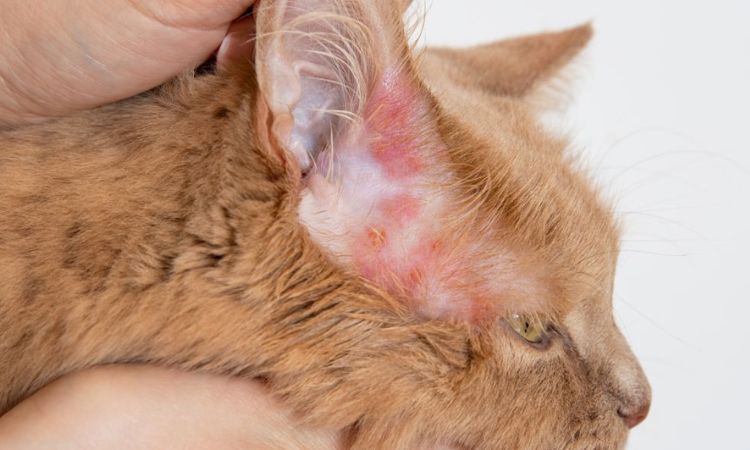
Elimination Diet Trial
A hypoallergenic elimination diet trial is the most reliable method to identify food sensitivities. This process involves feeding your cat a diet that contains proteins they have never eaten before (novel protein) or hydrolyzed proteins broken down to amino acids too small to trigger an immune response.
Key components of a proper elimination diet trial include:
- Duration
- Typically 8–12 weeks, as it can take at least four weeks for the immune system to adjust and up to eight weeks to observe improvement in symptoms.
- Dietary restrictions
- Only feed the prescribed hypoallergenic diet—no treats, flavored medications, or table scraps.
- Ensure all household pets are separated during feeding to prevent accidental ingestion of the wrong food.
- Thoroughly clean bowls and feeding areas before starting the trial.
- Introduce the new diet gradually over 3–7 days to reduce digestive upset.
- Expected outcomes
- A significant reduction in symptoms such as itching, skin lesions, vomiting, or diarrhea indicates a positive response.
- After improvement, your veterinarian may perform a rechallenge, reintroducing previous foods one at a time to identify the exact allergen. Each food is typically fed for 10–14 days while monitoring for recurrence of symptoms.
Importance of Professional Guidance and Patience
Diagnosing food sensitivities in cats is not a DIY process. It requires veterinary oversight to:
- Ensure nutritional adequacy during the elimination diet.
- Monitor for secondary infections or complications.
- Accurately interpret symptom changes and determine if a rechallenge is necessary.
Patience is essential. Accidental ingestion of a non-compliant food, treats, or flavored medication can invalidate weeks of progress, forcing the trial to restart. Owners should commit fully to the trial and maintain open communication with their veterinarian throughout the process.
With professional guidance and careful adherence to the elimination diet protocol, most cats with food sensitivities can achieve symptom relief, improved quality of life, and a clear identification of the foods to avoid.
Frequently Asked Questions
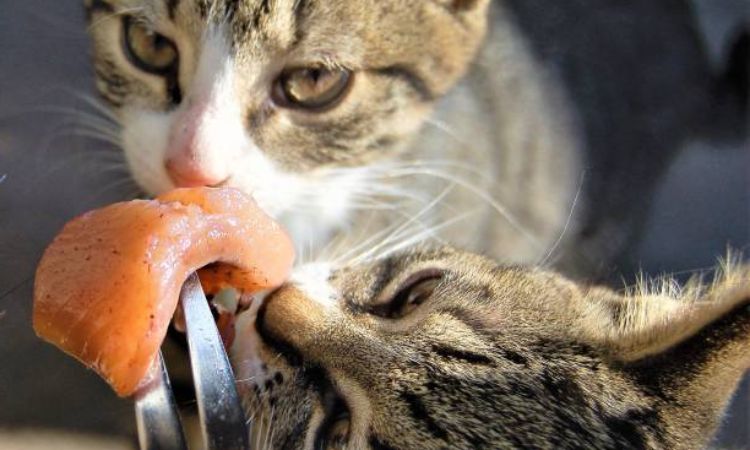
Can cats be allergic to chicken, fish, or beef?
Yes. Cats are most commonly allergic to animal proteins, including chicken, fish, and beef. These proteins can trigger an immune response in sensitive cats, resulting in symptoms such as persistent itching, skin lesions, hair loss, vomiting, diarrhea, and sometimes ear infections. While these are the most common triggers, cats can also develop allergies to other proteins like lamb, turkey, pork, or novel proteins such as venison or duck. Even ingredients that seem benign, such as dairy products, eggs, or certain grains, can occasionally cause allergic reactions.
How long does it take to see improvement?
Improvement in symptoms typically occurs during a strict elimination diet trial, which usually lasts 8 to 12 weeks. The immune system generally needs about four weeks to adjust to the new hypoallergenic diet, and it may take up to eight weeks to notice a significant reduction in clinical signs. In some cases, secondary infections, such as bacterial or yeast infections, may require treatment before symptoms fully improve. Patience and strict adherence to the prescribed diet are essential, as even small deviations like giving treats, flavored medications, or allowing the cat to eat from other pets’ bowls can delay or mask improvements.
What is the difference between food allergies and food intolerances?
While often confused, food allergies and food intolerances are distinct:
- Food Allergies involve the immune system. The cat’s body overreacts to a specific ingredient, usually a protein, producing antibodies that trigger inflammation. Symptoms often include itching, skin lesions, hair loss, gastrointestinal upset, and sometimes recurrent ear infections. Allergies can appear at any age, even after long-term exposure to the same food.
- Food Intolerances do not involve the immune system. They are typically caused by the cat’s inability to digest or metabolize certain ingredients, such as lactose in dairy or specific food additives. Symptoms usually involve the digestive system, including vomiting, diarrhea, gas, or bloating, but rarely cause skin problems or immune reactions.
Correct diagnosis is important because management strategies differ: allergies require strict avoidance of trigger ingredients, often through a veterinary-supervised elimination diet, while intolerances may be managed by gradual dietary changes or enzyme supplementation.



